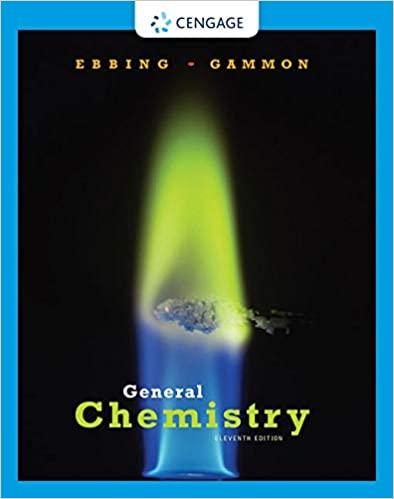Answered step by step
Verified Expert Solution
Question
1 Approved Answer
The helium ion, He+, has energy level similar to those of the hydrogen atom, since both species have only one electron. The energy levels of
The helium ion, He+, has energy level similar to those of the hydrogen atom, since both species have only
one electron. The energy levels of the He+ ion are given by the equation
En = 2 n
? 5248.16
kJ/mole n = 1, 2, 3,
1. Calculate the energies in kJ/mole for the four lowest energy levels of the He+ ion.
E1 = _______-5248.16________ kJ/mole
E2 = ______-1312.04_________ kJ/mole
E3 = _______-583.13________ kJ/mole
E4 = ________-328.01_______ kJ/mole
2. One of the most important transitions for the He+ ion involves a jump from the n = 2 to the n = 1
level. ?E for this transition equals E2 ? E1, where these two energies are obtained as above. Find
the value of ?E in kJ/mole. Find the wavelength in nm of the line emitted when this transition
occurs; use equation (4) to make the calculation.
?E = ______3936.12_________ kJ/mole; lambda= ____30.40___________ nm
3. Three of the strongest lines in the He+ ion spectrum are observed at the following wavelengths:
(1) 121.57 nm; (2) 164.12 nm; (3) 25.64 nm. Find the quantum numbers of the initial and final
states for the transitions that give rise to these three lines. Do this by calculating, using equation
(4), the wavelengths of lines that can originate from transitions involving any two of the four
lowest levels. You calculated one such wavelength in Part B. Make similar calculations with the
other possible pairs of levels. When a calculated wavelength matches an observed one, write
down nhi and nlo for that line. Continue until you have assigned all three of the lines. Make your
calculations below.
(1) _____4___ > ____2____ (2) ___3_____ >______2___ (3) ___????_____ > ____????____
one electron. The energy levels of the He+ ion are given by the equation
En = 2 n
? 5248.16
kJ/mole n = 1, 2, 3,
1. Calculate the energies in kJ/mole for the four lowest energy levels of the He+ ion.
E1 = _______-5248.16________ kJ/mole
E2 = ______-1312.04_________ kJ/mole
E3 = _______-583.13________ kJ/mole
E4 = ________-328.01_______ kJ/mole
2. One of the most important transitions for the He+ ion involves a jump from the n = 2 to the n = 1
level. ?E for this transition equals E2 ? E1, where these two energies are obtained as above. Find
the value of ?E in kJ/mole. Find the wavelength in nm of the line emitted when this transition
occurs; use equation (4) to make the calculation.
?E = ______3936.12_________ kJ/mole; lambda= ____30.40___________ nm
3. Three of the strongest lines in the He+ ion spectrum are observed at the following wavelengths:
(1) 121.57 nm; (2) 164.12 nm; (3) 25.64 nm. Find the quantum numbers of the initial and final
states for the transitions that give rise to these three lines. Do this by calculating, using equation
(4), the wavelengths of lines that can originate from transitions involving any two of the four
lowest levels. You calculated one such wavelength in Part B. Make similar calculations with the
other possible pairs of levels. When a calculated wavelength matches an observed one, write
down nhi and nlo for that line. Continue until you have assigned all three of the lines. Make your
calculations below.
(1) _____4___ > ____2____ (2) ___3_____ >______2___ (3) ___????_____ > ____????____
Step by Step Solution
★★★★★
3.49 Rating (159 Votes )
There are 3 Steps involved in it
Step: 1

Get Instant Access to Expert-Tailored Solutions
See step-by-step solutions with expert insights and AI powered tools for academic success
Step: 2

Step: 3

Ace Your Homework with AI
Get the answers you need in no time with our AI-driven, step-by-step assistance
Get Started


